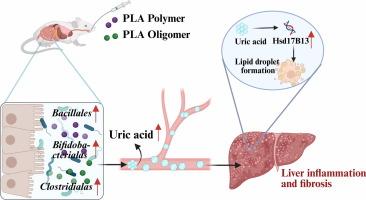聚乳酸微塑料致肝毒性:肠道菌群和尿酸代谢的中介作用
IF 13
1区 综合性期刊
Q1 MULTIDISCIPLINARY SCIENCES
引用次数: 0
摘要
生物可降解塑料的使用越来越多,导致人类不可避免地消耗生物可降解微塑料(MPs)。这些MPs可以通过胃肠道被降解和吸收到各种器官和组织中,肝脏是消化和吸收的主要目标。目的探讨可生物降解多磺酸粘多糖胃肠道降解后对肝脏的毒性作用及其机制。方法以聚乳酸(PLA)为代表生物塑料。我们使用聚合和低聚PLA MPs模拟原始和部分降解状态。小鼠以符合环境要求的浓度,通过28天的反复灌胃给予这些MPs。采用体内多组学分析结合体外研究来探索其潜在机制。结果暴露于聚乳酸低聚物和聚合物中会破坏肠道微生物群,导致小鼠血浆和肝脏尿酸水平升高。尿酸水平升高反过来又上调肝脏中Hsd17b13 mRNA的表达。这种级联反应与肝脏甘油三酯的积累有关,引发肝脏炎症并促进纤维化的进展。肠道微生物群的清除减轻了PLA mp诱导的小鼠肝损伤。在HepG2细胞中,聚乳酸低聚物和聚合物并没有增强HSD17B13 mRNA的表达或增加细胞脂滴的形成。相反,尿酸的存在上调了HSD17B13并增加了脂滴的产生。此外,同时暴露于聚乳酸颗粒和尿酸并不会增强这些细胞内的脂质积累或脂滴形成。结论PLA mp诱导的肝损伤是由肠道菌群驱动的尿酸升高介导的。这突出了系统因素,特别是肠道微生物群,在评估PLA MPs的肝毒性中的关键作用。本文章由计算机程序翻译,如有差异,请以英文原文为准。

Hepatotoxicity induced by polylactic acid microplastics: The mediating role of gut microbiota and uric acid metabolism
Introduction
The increasing use of biodegradable plastics has led to the inevitable human consumption of biodegradable microplastics (MPs). These MPs can be degraded and absorbed into various organs and tissues via the gastrointestinal tract, with the liver being the primary target for digestion and absorption.Objectives
This study aimed to investigate the toxic effects and mechanisms of biodegradable MPs on the liver following gastrointestinal degradation.Methods
Polylactic acid (PLA) was used as a representative bioplastic. We simulated pristine and partially degraded states using polymeric and oligomeric PLA MPs. Mice were exposed to these MPs via 28-day repeated gavage administration at environmentally realistic concentrations. In vivo multi-omics analyses, combined with in vitro studies, were employed to explore underlying mechanisms.Results
Exposure to PLA oligomers and polymers disrupted gut microbiota, triggering an increase in plasma and hepatic uric acid levels in the mice. Elevated uric acid levels, in turn, upregulated the Hsd17b13 mRNA expression in the liver. This cascade was linked to an accumulation of hepatic triglycerides, triggering liver inflammation and promoting the progression of fibrosis. The clearance of the intestinal microbiota mitigated PLA MP-induced liver injury in mice. In HepG2 cells, PLA oligomers and polymers did not enhance the HSD17B13 mRNA expression or increase cellular lipid droplet formation. Conversely, the presence of uric acid upregulated the HSD17B13 and augmented lipid droplet production. Furthermore, simultaneous exposure to PLA particles and uric acid did not intensify lipid accumulation or lipid droplet formation within these cells.Conclusion
Our findings demonstrate that PLA MP-induced liver damage is mediated by gut microbiota-driven elevation of uric acid. This highlights the critical role of systemic factors, particularly gut microbiota, in assessing the hepatotoxicity of PLA MPs.求助全文
通过发布文献求助,成功后即可免费获取论文全文。
去求助
来源期刊

Journal of Advanced Research
Multidisciplinary-Multidisciplinary
CiteScore
21.60
自引率
0.90%
发文量
280
审稿时长
12 weeks
期刊介绍:
Journal of Advanced Research (J. Adv. Res.) is an applied/natural sciences, peer-reviewed journal that focuses on interdisciplinary research. The journal aims to contribute to applied research and knowledge worldwide through the publication of original and high-quality research articles in the fields of Medicine, Pharmaceutical Sciences, Dentistry, Physical Therapy, Veterinary Medicine, and Basic and Biological Sciences.
The following abstracting and indexing services cover the Journal of Advanced Research: PubMed/Medline, Essential Science Indicators, Web of Science, Scopus, PubMed Central, PubMed, Science Citation Index Expanded, Directory of Open Access Journals (DOAJ), and INSPEC.
 求助内容:
求助内容: 应助结果提醒方式:
应助结果提醒方式:


